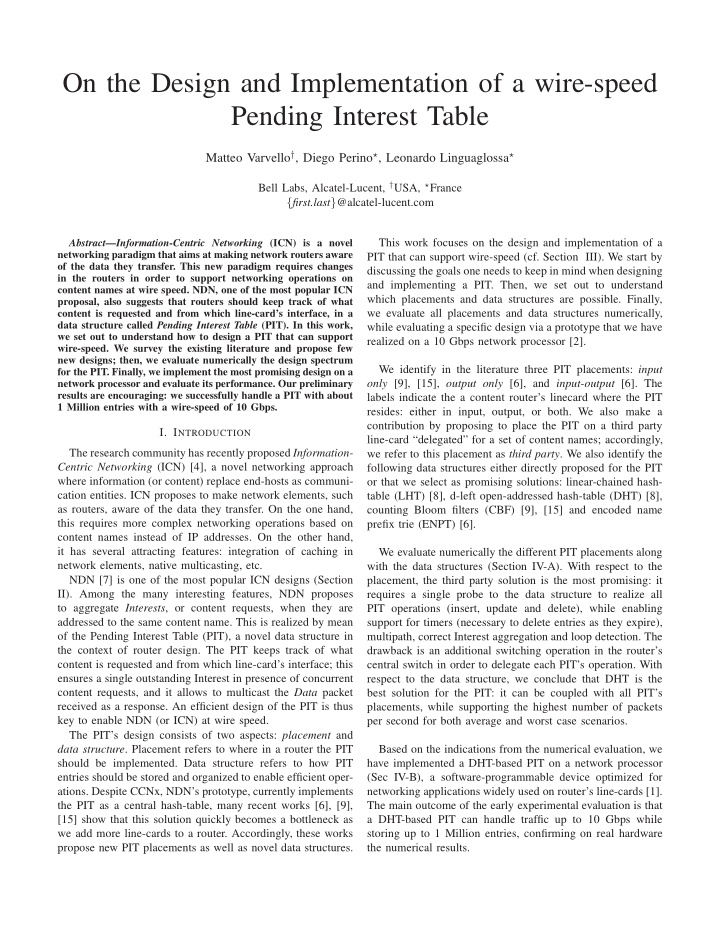



On the Design and Implementation of a wire-speed Pending Interest Table Matteo Varvello † , Diego Perino ⋆ , Leonardo Linguaglossa ⋆ Bell Labs, Alcatel-Lucent, † USA, ⋆ France { first.last } @alcatel-lucent.com This work focuses on the design and implementation of a Abstract — Information-Centric Networking (ICN) is a novel networking paradigm that aims at making network routers aware PIT that can support wire-speed (cf. Section III). We start by of the data they transfer. This new paradigm requires changes discussing the goals one needs to keep in mind when designing in the routers in order to support networking operations on and implementing a PIT. Then, we set out to understand content names at wire speed. NDN, one of the most popular ICN which placements and data structures are possible. Finally, proposal, also suggests that routers should keep track of what content is requested and from which line-card’s interface, in a we evaluate all placements and data structures numerically, data structure called Pending Interest Table (PIT). In this work, while evaluating a specific design via a prototype that we have we set out to understand how to design a PIT that can support realized on a 10 Gbps network processor [2]. wire-speed. We survey the existing literature and propose few new designs; then, we evaluate numerically the design spectrum We identify in the literature three PIT placements: input for the PIT. Finally, we implement the most promising design on a network processor and evaluate its performance. Our preliminary only [9], [15], output only [6], and input-output [6]. The results are encouraging: we successfully handle a PIT with about labels indicate the a content router’s linecard where the PIT 1 Million entries with a wire-speed of 10 Gbps. resides: either in input, output, or both. We also make a contribution by proposing to place the PIT on a third party I. I NTRODUCTION line-card “delegated” for a set of content names; accordingly, The research community has recently proposed Information- we refer to this placement as third party . We also identify the Centric Networking (ICN) [4], a novel networking approach following data structures either directly proposed for the PIT where information (or content) replace end-hosts as communi- or that we select as promising solutions: linear-chained hash- cation entities. ICN proposes to make network elements, such table (LHT) [8], d-left open-addressed hash-table (DHT) [8], as routers, aware of the data they transfer. On the one hand, counting Bloom filters (CBF) [9], [15] and encoded name this requires more complex networking operations based on prefix trie (ENPT) [6]. content names instead of IP addresses. On the other hand, it has several attracting features: integration of caching in We evaluate numerically the different PIT placements along network elements, native multicasting, etc. with the data structures (Section IV-A). With respect to the NDN [7] is one of the most popular ICN designs (Section placement, the third party solution is the most promising: it II). Among the many interesting features, NDN proposes requires a single probe to the data structure to realize all to aggregate Interests , or content requests, when they are PIT operations (insert, update and delete), while enabling addressed to the same content name. This is realized by mean support for timers (necessary to delete entries as they expire), of the Pending Interest Table (PIT), a novel data structure in multipath, correct Interest aggregation and loop detection. The the context of router design. The PIT keeps track of what drawback is an additional switching operation in the router’s content is requested and from which line-card’s interface; this central switch in order to delegate each PIT’s operation. With ensures a single outstanding Interest in presence of concurrent respect to the data structure, we conclude that DHT is the content requests, and it allows to multicast the Data packet best solution for the PIT: it can be coupled with all PIT’s received as a response. An efficient design of the PIT is thus placements, while supporting the highest number of packets key to enable NDN (or ICN) at wire speed. per second for both average and worst case scenarios. The PIT’s design consists of two aspects: placement and data structure . Placement refers to where in a router the PIT Based on the indications from the numerical evaluation, we should be implemented. Data structure refers to how PIT have implemented a DHT-based PIT on a network processor entries should be stored and organized to enable efficient oper- (Sec IV-B), a software-programmable device optimized for ations. Despite CCNx, NDN’s prototype, currently implements networking applications widely used on router’s line-cards [1]. the PIT as a central hash-table, many recent works [6], [9], The main outcome of the early experimental evaluation is that [15] show that this solution quickly becomes a bottleneck as a DHT-based PIT can handle traffic up to 10 Gbps while we add more line-cards to a router. Accordingly, these works storing up to 1 Million entries, confirming on real hardware propose new PIT placements as well as novel data structures. the numerical results.
Recommend
More recommend